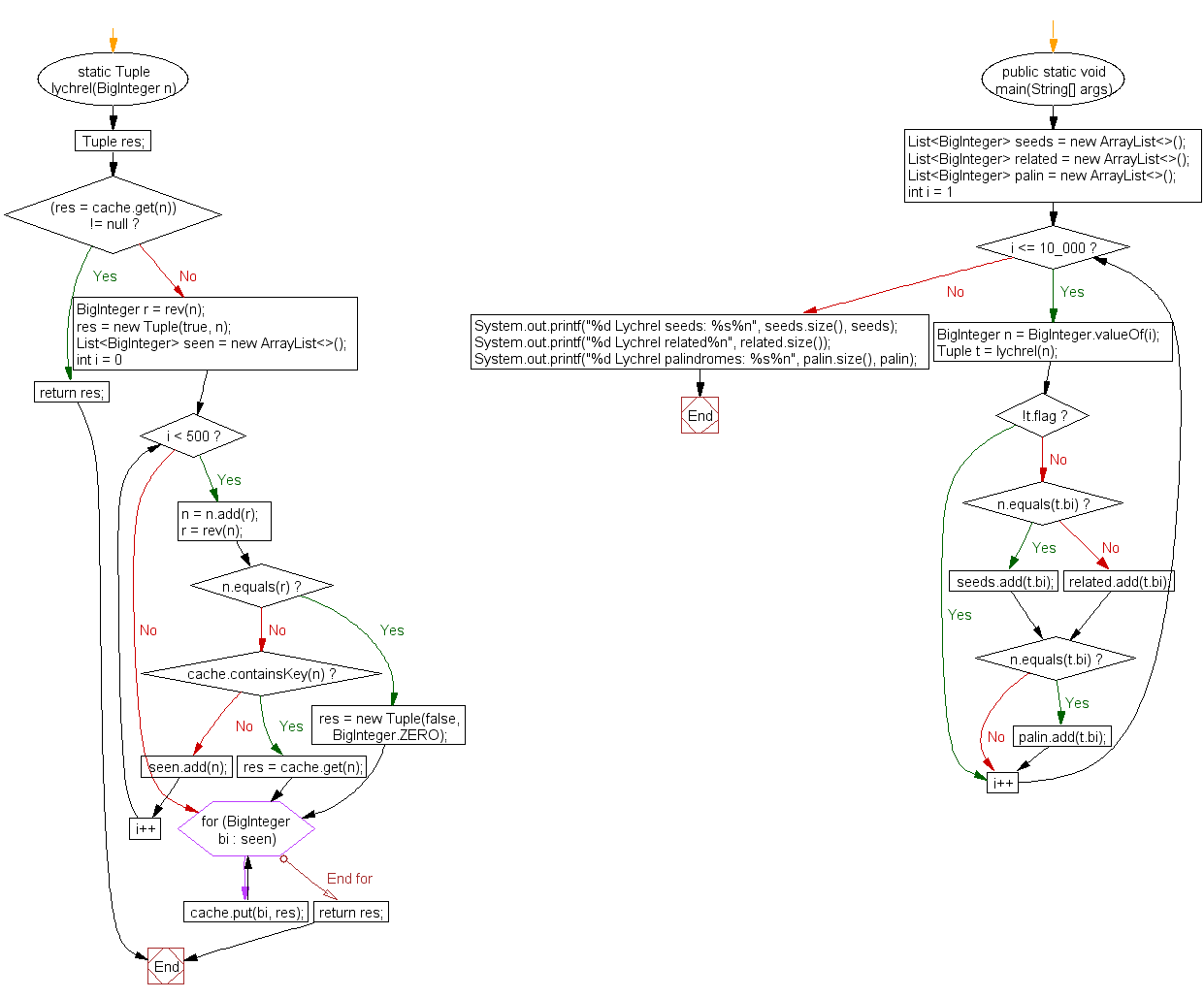Java: Find the number of seed Lychrel number candidates and related numbers for n in the range 1..10000 inclusive.
Seed Lychrel Numbers
Write a Java program to find the number of seed Lychrel number candidates and related numbers for n in the range 1..10000 inclusive. (With a 500-iteration limit).
A Lychrel number is a natural number that cannot form a palindrome through the iterative process of repeatedly reversing its digits and adding the resulting numbers. This process is sometimes called the 196-algorithm, after the most famous number associated with the process.
The first few Lychrel numbers are 196, 295, 394, 493, 592, 689, 691, 788, 790, 879, 887, ... .
Pictorial Presentation:
Sample Solution:
Java Code:
// https://rosettacode.org/
import java.math.BigInteger;
import java.util.*;
public class Example5 {
static Map<BigInteger, Tuple> cache = new HashMap<>();
static class Tuple {
final Boolean flag;
final BigInteger bi;
Tuple(boolean f, BigInteger b) {
flag = f;
bi = b;
}
}
static BigInteger rev(BigInteger bi) {
String s = new StringBuilder(bi.toString()).reverse().toString();
return new BigInteger(s);
}
static Tuple lychrel(BigInteger n) {
Tuple res;
if ((res = cache.get(n)) != null)
return res;
BigInteger r = rev(n);
res = new Tuple(true, n);
List<BigInteger> seen = new ArrayList<>();
for (int i = 0; i < 500; i++) {
n = n.add(r);
r = rev(n);
if (n.equals(r)) {
res = new Tuple(false, BigInteger.ZERO);
break;
}
if (cache.containsKey(n)) {
res = cache.get(n);
break;
}
seen.add(n);
}
for (BigInteger bi : seen)
cache.put(bi, res);
return res;
}
public static void main(String[] args) {
List<BigInteger> seeds = new ArrayList<>();
List<BigInteger> related = new ArrayList<>();
List<BigInteger> palin = new ArrayList<>();
for (int i = 1; i <= 10_000; i++) {
BigInteger n = BigInteger.valueOf(i);
Tuple t = lychrel(n);
if (!t.flag)
continue;
if (n.equals(t.bi))
seeds.add(t.bi);
else
related.add(t.bi);
if (n.equals(t.bi))
palin.add(t.bi);
}
System.out.printf("%d Lychrel seeds: %s%n", seeds.size(), seeds);
System.out.printf("%d Lychrel related%n", related.size());
System.out.printf("%d Lychrel palindromes: %s%n", palin.size(), palin);
}
}
Sample Output:
5 Lychrel seeds: [196, 879, 1997, 7059, 9999] 244 Lychrel related 5 Lychrel palindromes: [196, 879, 1997, 7059, 9999]
Flowchart:

For more Practice: Solve these Related Problems:
- Write a Java program to identify candidate Lychrel numbers in a range using the reverse-and-add process with a user-defined iteration limit.
- Write a Java program to display the sequence of reverse-and-add operations for a suspected Lychrel number.
- Write a Java program to count Lychrel seeds and related numbers using multi-threading for performance improvement.
- Write a Java program to analyze and cache intermediate results in the Lychrel detection process to avoid redundant calculations.
Go to:
PREV : Kaprekar Numbers < 1000.
NEXT : First 15 Narcissistic Numbers.
Java Code Editor:
Contribute your code and comments through Disqus.
What is the difficulty level of this exercise?
Test your Programming skills with w3resource's quiz.
